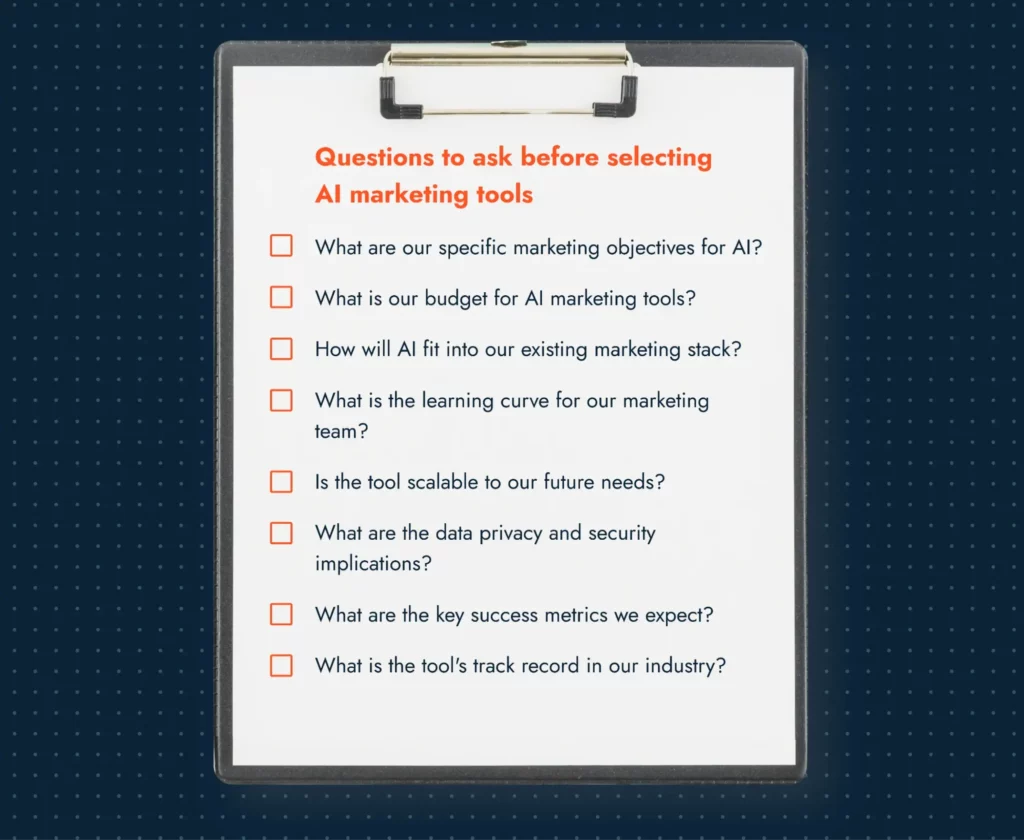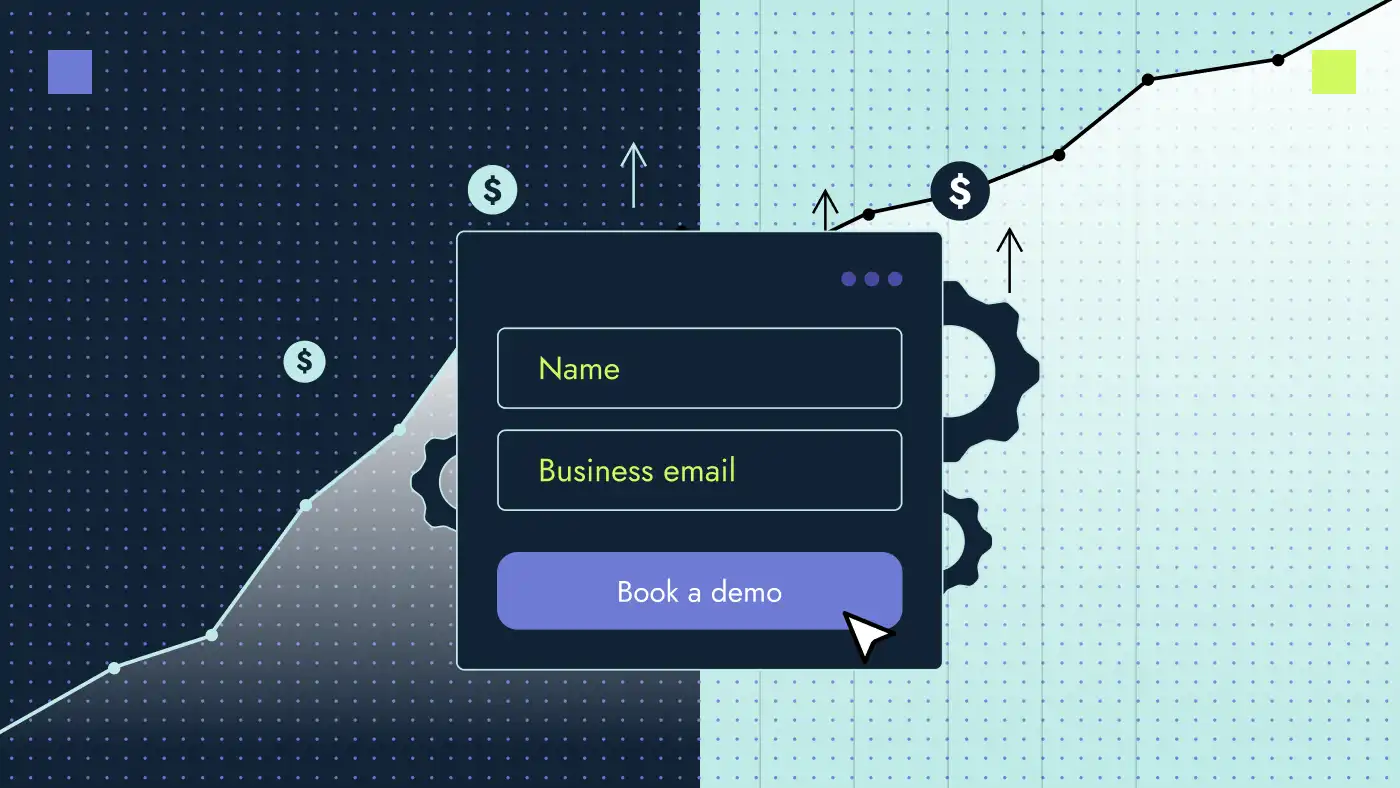AI is pervasive in our lives, from playing music on Alexa to unlocking our phones using facial recognition. Many companies — particularly the marketing teams — are rapidly adopting AI solutions to improve their bottom line. A report by PwC predicts that deploying AI will add $15.7 trillion to the global economy by 2030.
For CMOs, artificial intelligence is the key to transforming marketing strategies into revenue-generating success stories. Marketing teams have been using AI on platforms like Google and Facebook for over a decade to show the right content to the right audience.
While a growing number of companies have incorporated AI in marketing, some teams are still struggling to develop a strategy. In this article, I’ll explore the most prevalent concerns of implementing AI marketing and propose solutions to help CMOs and fractional CMOs.
What is AI in marketing?
Artificial intelligence in marketing is the use of AI technologies such as machine learning (ML) and natural language processing (NLP) to:
- Analyze data
- Automate repetitive tasks
- Make data driven decisions
These capabilities ultimately improve the efficiency and effectiveness of marketing campaigns.
By understanding your buyers’ personas, preferences and needs, you can enhance B2B digital marketing strategies and optimize the customer journey. Research by McKinsey found that investing in AI leads to a revenue uplift of 3-15% and a 10-20% sales ROI increase.
From our team’s experience on SaaS projects, I’ve put together the below table of common uses of AI for your marketing teams.
| AI application | Description | Use cases and benefits | Tool examples |
|---|---|---|---|
| Predictive analytics | Predict customer behavior, preferences and trends. | Predictive lead scoring, churn prediction, personalized recommendations and market trend analysis | IBM Watson, Salesforce Einstein and Google Analytics |
| Natural language processing (NLP) and content generation | Analyze and generate text-based content. | Sentiment analysis, chatbots for customer support and automated content creation | OpenAI GPT-4, Jasper, IBM Watson NLU and Chatfuel |
| Computer vision | Examine and generate visual content. | Image recognition, video analysis and personalized visual recommendations | Amazon Rekognition, Midjourney and Adobe Sensei |
| Marketing automation and personalization | Automate marketing tasks and personalize content. | Email marketing automation, dynamic content and personalized landing pages | HubSpot, Marketo and Mailchimp |
| Chatbots and conversational marketing | Enable real-time customer interactions. | Chatbots for website, social media, and messaging apps and lead qualification | Dialogflow, Intercom and Zendesk Chat |
| Marketing attribution and ROI analysis | Evaluate the impact of marketing campaigns. | Multi-touch attribution modeling and ROI analysis | Attribution.io, Bizible and Adobe Analytics |
| Voice search and voice assistants | Optimize for voice search and interaction. | Voice search optimization and voice driven content | Amazon Alexa Skills Kit, Google Assistant Actions and Microsoft Cortana |
| AI in advertising | Execute data-driven advertising campaigns. | Programmatic advertising, ad targeting and A/B testing | Google Ads, Facebook Ads Manager and Adobe Advertising Cloud |
| Social media analysis | Evaluate social media data. | Social sentiment analysis, trend detection and influencer identification | Brandwatch, Socialbakers and Hootsuite |
| Data analytics and insights | Review large datasets for marketing insights. | Data-driven decision-making, customer segmentation and competitor analysis | Tableau, QlikView and Domo |
| AI-enhanced customer experience | Improve overall customer experience. | Personalized user journeys and interactive content | Salesforce Service Cloud, Adobe Experience Cloud and Zendesk Guide |
| Market research | Enhance market research efforts. | Automated surveys, sentiment analysis and competitor intelligence | SurveyMonkey, Brandwatch Consumer Research and Qualtrics |
| Email marketing | Optimize email campaigns. | Personalized email content and automated email responses | SendGrid, Persado and Phrasee |
| AI in SEO and content optimization | Improve website visibility and content performance. | SEO keyword optimization and content recommendations | SEMrush, Ahrefs and BrightEdge |
How B2B digital marketing teams can use AI
By incorporating AI marketing, B2B teams streamline processes and gain a competitive edge in engaging with the ideal customer profile. The graphic below shows how marketers can use AI and machine learning throughout the sales funnel.

Source: Smart Insights
Here is a step-by-step guide, with an example, of how to incorporate AI into your marketing strategy:
Planning and goal setting
In this initial phase, ensure alignment between AI marketing goals and broader business objectives for a cohesive strategy. Identify areas where AI in digital marketing can uniquely address your goals, such as improving customer retention by predicting churn patterns.
For example, your goal setting can follow a three-step process:
Step 1: Determine business objective: Your B2B SaaS company aims to increase website organic traffic and generate high-quality leads.
Step 2: Analyse current gaps: To achieve the objective, you need to analyze current content and SEO strategy. Identify gaps for AI in content marketing to address, such as creating industry-specific blog posts or optimizing product descriptions.
Step 3: Specify marketing goal: Set a specific goal that will help you increase traffic and generate leads, like achieving a 30% increase in organic traffic within the next six months.
Data preparation and integration
Data quality is paramount. Beyond cleanliness, consider data diversity and depth. Collect data from multiple sources for a holistic view of your customers. Additionally, focus on real-time data integration to enable timely decision-making.
After establishing goals for organic traffic, ensure your website analytics and CRM data are integrated seamlessly. This integration allows AI tools to access information about leads and customer behaviors, helping in personalized content generation.
AI solution selection and integration
When selecting AI marketing solutions, think of long-term scalability. Ensure compatibility with your current technology stack, but also evaluate how these solutions can adapt as your business grows. Prioritize solutions that offer flexibility and customization to address your unique marketing needs.
Once you have ensured the data quality from CRM and analytics tools, you can use ChatGPT or other AI text generators, like Jasper, to generate your first draft. Platforms like MarketMuse and Clearscope can analyze top-ranking articles on your chosen topics and provide data driven content suggestions.
🖊️ Learn how to avoid sloppy copy in SEO writing.
Team training and skill development
Beyond basic training, cultivate a culture of curiosity and experimentation within your marketing and data teams. Encourage them to continuously explore AI’s potential and adapt to changing market dynamics. Foster cross-functional collaboration to maximize AI’s impact, as insights from data scientists should inform marketers’ strategies and vice versa.
Train your B2B content team to fuse AI writing tools and their human expertise. According to Wordtune, bloggers who use AI save one hour to write a 2,000-word post compared to bloggers who don’t use AI.
Encourage your SEO team to collaborate closely with content creators and ghost writers to optimize AI-generated content for search engines.
💡 Keep reading: The future of content teams
Implementation, monitoring and optimization
Pilot projects offer an excellent opportunity to learn and adapt. Use A/B testing to evaluate how effective your AI driven strategies are against traditional approaches. Continuously monitor performance and be ready to pivot based on real-time data. Understand that AI isn’t a one-time solution; it’s an ongoing process of optimization and adaptation.
Understand your team’s AI maturity
AI maturity analyses to what degree organizations have mastered AI-related capabilities to achieve high performance. CMOs should understand their current stage of AI adoption and set goals for advancement accordingly.
Each stage represents a different level of maturity.
| Stage | Discovery | Learning | Integration | Value realization | Innovation |
|---|---|---|---|---|---|
| Ranking | 1 | 2 | 3 | 4 | 5 |
| Description | The organization is in the early stages of exploring AI, with limited experience and adoption. | The organization recognizes AI's potential and is actively seeking knowledge and expertise. | AI is integral to marketing strategies and is consistently used for various tasks. | Tangible business benefits through AI adoption, improves KPIs and customer experiences. | The organization is a leader in AI-driven marketing, actively innovating and creating custom AI solutions. |
| Benefits | No clear benefit; at times, AI tools are viewed as technology debt. | Potential to add a competitive edge as the team gains a head start in understanding emerging trends. | AI is critical to operational efficiency and reducing overall marketing costs. | Personalized customer experiences increase repeat business, which is more profitable than acquiring new customers. | Leadership in AI reduces wasteful spending and optimizes resource allocation, improving cost efficiency. |
1. Discovery
The organization is in the early phases of exploring AI in marketing; there’s minimal experience and limited AI adoption. Key characteristics:
- Basic awareness of AI technologies
- Limited use of AI for simple tasks like email automation
- Initial experimentation with AI tools
2. Learning and exploration
In the learning stage, the organization has recognized the potential of AI in marketing and is actively seeking knowledge and expertise. Key characteristics:
- Investment in AI training and education for marketing teams
- Exploring a wider range of AI tools and platforms
- Experimentation with more advanced AI applications, such as chatbots or predictive analytics
3. Integration and optimization
The organization has successfully integrated AI into various marketing processes and campaigns at this stage. Key characteristics:
- AI is an integral part of marketing strategies
- Consistent use of AI tools for tasks like personalization, content generation and customer segmentation
- Measurable improvements in marketing KPIs, such as increased conversion rates or ROI
4. Value realization
At the benefiting stage, the organization is reaping significant rewards from AI adoption, achieving tangible business benefits. Key characteristics:
- AI driven marketing efforts consistently outperform traditional methods
- Enhanced customer experiences and higher customer satisfaction
- AI is contributing to revenue growth, customer retention and competitive advantage
5. Building and innovation
In the building stage, the organization has become a leader in AI driven marketing and is actively innovating with AI solutions. Key characteristics:
- In-house development of AI algorithms and models tailored to specific marketing needs
- Collaborations with AI research and development teams
- Leading industry trends and setting benchmarks in AI marketing practices
Five key challenges of adopting AI in B2B marketing
While using AI in marketing offers significant advantages, it also presents several complexities. Here are the five top challenges that CMOs face with adopting artificial intelligence in marketing:
1. Poor data quality
Businesses struggle to source and maintain high-quality data, which can hinder the performance of AI marketing strategy. Poor data quality directly costs the average organization $12.9 million annually, Gartner estimated.
Inaccurate and incomplete data can mislead AI algorithms, leading to flawed predictions. If the data used to train AI models has a bias, the AI marketing tools will also perpetuate bias. For instance, if training data is biased toward a particular demographic, the AI toll may inadvertently favor that group in marketing campaigns.
Storing data in separate silos makes it challenging for AI systems to access and integrate data. This fragmented approach hinders personalized marketing efforts.
2. Overload of AI marketing tools
While the range of AI marketing tools lets you experiment and improvise, the crowded landscape creates a paradox of choice. Tool overload leads to:
- Decision paralysis, wherein marketers are confused about choosing the appropriate tool among the many options available
- Inefficient resource allocation — wasting funds and time on tools that do not align with marketing objectives
3. Data privacy and security
AI in marketing relies on collecting and analyzing customer data, including personal information. Privacy concerns arise when customers feel their data is collected without consent or used in ways they did not anticipate. In a poll by Ipsos, 84% of respondents showed concern about the safety and privacy of the personal data they provide on the internet.
Marketing teams must navigate a fine line between leveraging customer data for personalized experiences and respecting privacy rights. Apart from adhering to data protection regulations such as the General Data Protection Regulation (GDPR), marketers should collect only necessary data and avoid the over-collection of sensitive or unnecessary information.
4. Lack of AI digital marketing skills
While AI driven marketing is evolving rapidly, there is a growing gap for organizations to find skilled AI marketing talent. The AI Skills Gap study found that 51% of organizations don’t have the right mix of competent AI talent to bring their strategies to life.
With generative AI models such as GPT-4 transforming content creation, marketers can automate content creation, including text, video and images. Marketing teams, however, should be cognizant of adapting the content to fit their brand perception and voice.
5. Cost of implementation
The upfront and ongoing costs associated with AI implementation can be substantial. AI for marketing solutions comes with licensing fees and subscription costs, which vary depending on the vendor and the complexity of the tool.
Beyond the initial setup, AI systems require ongoing maintenance and support. This cost includes software updates, troubleshooting and addressing technical issues, which can add to operational costs.
Instead of adopting AI tools simply because your competitors are doing so, you should assess the potential ROI of every AI marketing tool before buying it. If you have a limited budget, consider AI solutions that allow for scalability, enabling you to start with a manageable investment and expand as needed.
How to overcome the challenges of AI marketing
Some marketers believe the right AI marketing tool is a magic potion that will completely automate their marketing strategy and execution. Artificial intelligence, however, is only as impactful as the human behind it.
Today, AI lacks two things that are important to successful marketing:
- Empathy: AI operates on algorithms and data analysis, lacking the ability to genuinely understand human emotions, context or nuanced situations in the same way humans can. The lack of empathy in copywriting tools can result in impersonal and tone-deaf content, leading to reduced customer engagement.
- Creativity: Predefined algorithms and data patterns limit AI’s ability to generate truly novel, imaginative and emotionally resonant ideas. The limited creativity leads to campaigns that feel formulaic and fail to capture the audience’s attention or create a lasting impact.
Remember that AI is a tool, not a silver bullet; it should align with your strategy rather than dictate it.
While well-applied AI in digital marketing drives success, the technology is not an adversary that will replace talented teams. Martech says two-thirds of marketers use generative AI for their brainstorming sessions. AI is simply a tool to enhance creative ideas developed through customer empathy.
🤖 Learn how to avoid AI writing patterns and output copy that ranks
Maximize your AI marketing productivity with Productive Shop
Are you looking to scale your content and conquer the ever-evolving landscape of SEO in the age of AI marketing? Work with our team that has a stellar record of catapulting B2B tech startups to thought leadership and business growth.
Our approach combines the best of both worlds – the potential of AI driven writing and human-backed contextual research and customer empathy.







